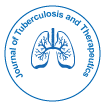Characteristics of HIV/TB Co-Infected Patients with Data of T-Spot TB Testing: Review of Practice Pattern in an HIV Outpatient Clinic in New Orleans, Louisiana
Received Date: Oct 12, 2017 / Accepted Date: Nov 20, 2017 / Published Date: Nov 27, 2017
Abstract
Objectives: We studied the characteristics of a cohort of HIV/ TB Infection co-infected patients in a HIV Outpatient Clinic in New Orleans to identify the methodology of screening, diagnosis and treatment of TB Infection (TBI).
Methods: A three-year retrospective review of 1,937 HIV-infected subjects co-infected with Mycobacterium tuberculosis (MTB) in which a T-SPOT®.TB test was done, and a borderline or positive T-SPOT®.TB result was found, were selected. HIV status, adherence to HIV antiretroviral therapy (ART), and clinic follow-up information were abstracted from provider notes. When repeat T-SPOT®.TB tests were performed, the results were abstracted to determine concordance and rates of conversion and reversion.
Results: Out of 1,937 HIV-infected subjects reviewed from 1/2012 to 12/2014, 68 (3.5%) showed a positive or borderline T-SPOT®.TB test. The cumulative prevalence of positive T-SPOT®.TB tests was 2.4%. In 19 subjects who were initially T-SPOT®.TB-test positive and had serial testing done, 11 tests (58%) reverted to negative. In 15 subjects with borderline test results the first time, tests in 10 subjects (67%) changed to negative; 2 changed to positive, and these subjects then progressed to active TB during the following 14 months. Eighty-seven percent of patients in this clinic were treated for TBI.
Conclusion: Other than HIV viral load and CD4-cell count, maintenance of normal weight and adherence to medical care may have also played a part in preventing the progression of TBI to active TB in this cohort. The propensity for change in the T-SPOT®.TB from borderline to negative and the rate of reversion from positive to negative confirms the importance of the test’s borderline category. The reasons for these variations warrant further understanding and review. Although the variations observed in some test results may impede screening for TBI with its limitations notwithstanding, targeted screening, especially in this cohort, remains the backbone of TB control.
Keywords: Tuberculosis; MTB; HIV; IGRA; TB infection
Citation: Frontini M, Ige M, Ali J (2017) Characteristics of HIV/TB Co-Infected Patients with Data of T-Spot TB Testing: Review of Practice Pattern in an HIV Outpatient Clinic in New Orleans, Louisiana. J Tuberc Ther 2: 108.
Copyright: © 2017 Frontini M, et al. This is an open-access article distributed under the terms of the Creative Commons Attribution License, which permits unrestricted use, distribution, and reproduction in any medium, provided the original author and source are credited.
Share This Article
Open Access Journals
Article Usage
- Total views: 4169
- [From(publication date): 0-2017 - Apr 03, 2025]
- Breakdown by view type
- HTML page views: 3285
- PDF downloads: 884
